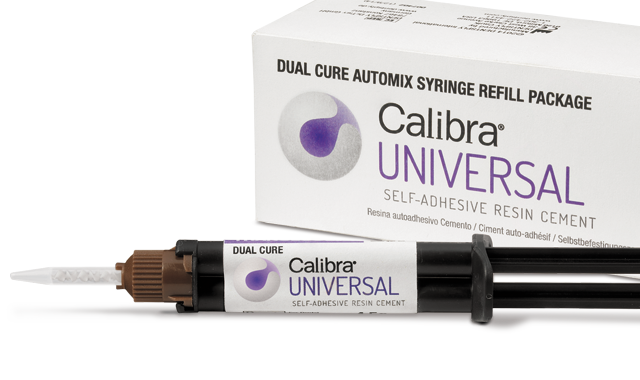“Calibra Universal had all of what we were looking for in a material”
The family of Calibra Dental Cements by DENTSPLY Caulk provides three different options for adhesive resins. Each of them allows for fast tack curing without the added stress caused by concerns about over curing. DPR talked to Dr. Phillip Kemp about his experience with DENTSPLY’s Calibra Dental Cements.

The tools you use in your restorations can make or break your success rates, quite literally. While preparation is essential to this, dental cement also plays a major role in their success rates. However, all cements are not created equal (by design). Finding the one that works for your restoration type is key to securing success. The family of Calibra Dental Cements by DENTSPLY Caulk provides three different options for adhesive resins. Each of them allows for fast tack curing without the added stress caused by concerns about over curing.
DPR talked to Dr. Phillip Kemp about his experience with DENTSPLY’s Calibra
Dental Cements. Dr. Kemp, of Brentwood, Tennessee, has been practicing since 1988.
Here’s what he had to say:
Dentists are creatures of habit and changing is difficult. I have a busy practice, so changing protocols is a big

ordeal. My sales rep urged me to try Calibra Dental Cement. Up to this point, I had used [another] resin cement, but I reluctantly tried Calibra and loved it. I used it again, and loved it again. Then, I tried it on a 20-unit case and seated it and thought, “Wow! This is pretty great.”
What do you like best about the product?
I live by the “keep it simple, stupid” mentality. Calibra Universal had all of what we were looking for in a material. I found it easy and it gave me excellent results. It doesn’t stick and has great handling properties. That is so much of what you look for, how it flows, how it cleans up and the ease of handling.
Related reading: Learning more about Calibra® Universal from DENTSPLY Caulk
Obviously, post-cementation, you look for color stability, margin adaption, all those things you look for in quality restorations. When we use a glass ionomer cement, it’s white, so sometimes you can have a color issue. With Calibra being a neutral, clear material, you have no color change.
It is easy to use. I find that Calibra Universal is easy to work with and there is no need for a bonding agent. There’s easy removal of excess--it will not harden quickly and will give you enough time to clean up, which is similar to resin modified glass ionomers.
Calibra doesn’t harden so quickly that you have embrasures that are difficult to clean up. Its good handling makes it easy to make sure you thoroughly remove excess cement.
What have been the results and/ or patient responses?
A patient has no idea what you are doing when you are luting that material to the teeth. They just think we glued their crown on, even though we didn’t glue it; we bonded it. One time, I was explaining my procedure to the patient when she said, “Honey, I only eat the sausage; I don’t want to know how it’s made!”
So from a patient’s perspective, no response is a great response, meaning they are happy with the outcome.
What benefits to your practice have you experienced?
If you have ease of clean up, you save chair time. If you save chair time, you save money. We are very efficient in how we try to do things. We look for material that works easily and quickly. Calibra fits right in with the protocols we already had without missing a beat.
My students do local outreach, and work with Hopesmiles.org. When we go to the inner city or work in Uganda or Haiti, we are doing surgeries and pulling teeth; we are not doing a lot of restorative work. But honestly, CAD/CAM and the advancements of digital dentistry are opening up new frontiers. When we get to the point where we can mill something, and save a tooth instead of just pulling it, Calibra is a great material to do that. You prep the tooth, fill it with Calibra, put it on and it’s done.
Why would you recommend this product to your colleagues?
Because it’s simple, easy to use and it works. If you have a material that bonds well and is easy to use, and all you have to do is fill the crown and put it on, that’s pretty idiot proof. And in my life, I need all the help I can get. I use Calibra Universal for IPS e.max cases and I’ll use Ceram for cases where it’s real hard to isolate and fight blood.
More on Calibra Dental Cements
With three prescriptive types of cements--Calibra Universal Self-Adhesive Resin Cement, Calibra Ceram Adhesive Resin Cement and Calibra Veneer Esthetic Resin Cement-- you can select the cement you need to create the successful, long-lasting restorations you want. An online Calibra Cement Select Tool makes it easy to choose the right product for any procedure. All of the prescriptive types of cement come with a wide tack cure window (up to 10 seconds), along with a 45-second gel phase, allowing you the time you need to clean up your restorations thoroughly and simply. The Calibra Dental Cement family was created to make excess cement on your restorations a thing of the past and provides you the tools you need to create a greater margin of success. For more information on Dentsply Sirona's cements, visit calibracement.com.
ACTIVA BioACTIVE Bulk Flow Marks Pulpdent’s First Major Product Release in 4 Years
December 12th 2024Next-generation bulk-fill dental restorative raises the standard of care for bulk-fill procedures by providing natural remineralization support, while also overcoming current bulk-fill limitations.